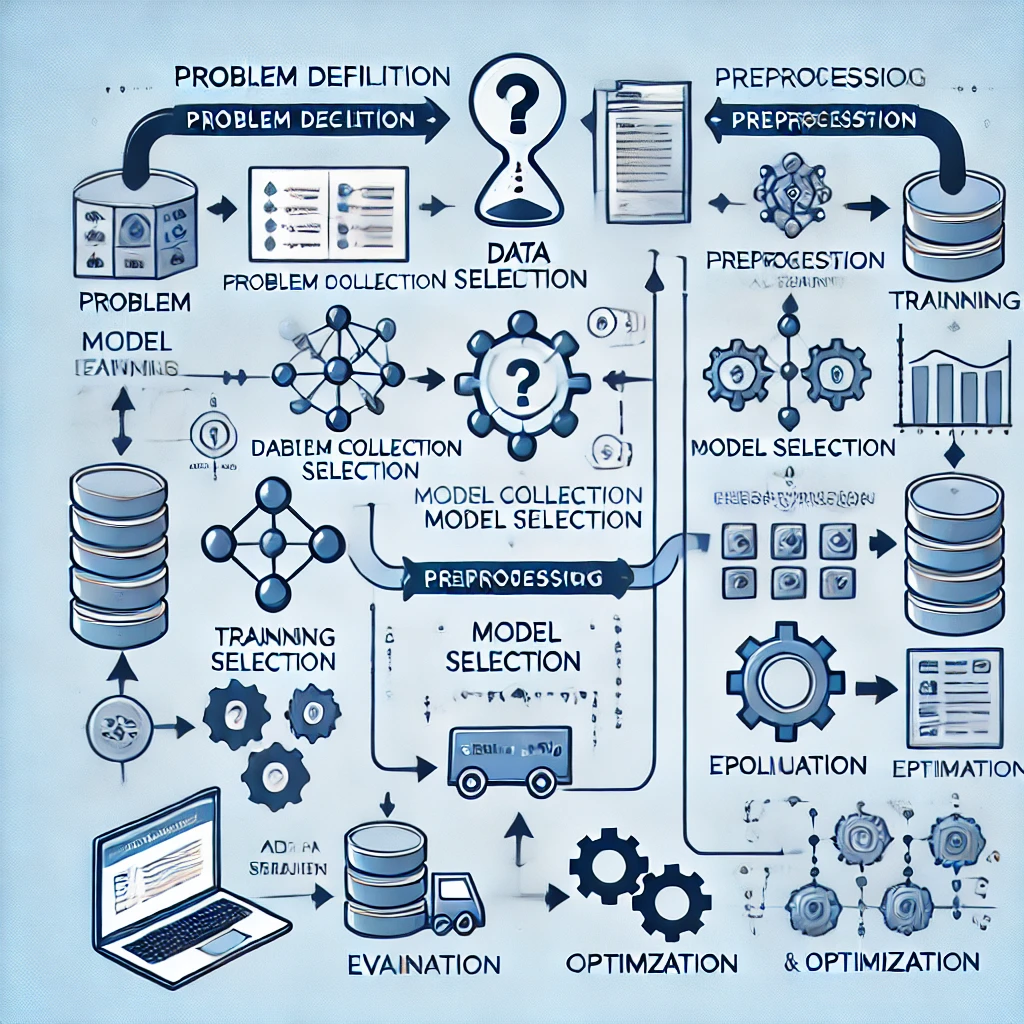To create a machine learning (ML) model, you typically follow a structured workflow. Here are the key steps:
- Define the Problem
- Collect Data
- Data Cleaning
- Exploratory Data Analysis (EDA)
- Data Transformation
- Feature Engineering
- Check for Outliers
- Split the Data
- Select a Model
- Train the Model
- Evaluate the Model
- Hyperparameter Tuning
- Model Optimization
- Interpret the Model
- Deploy the Model
- Monitor the Model
- Documentation & Reporting
1. Define the Problem:
Understand the Problem Type: Clearly define the problem you want to solve is classified, regression, clustering, etc.
Set Objective: Decide on the business or technical goals for the model (e.g. Maximize accuracy, Minimize cost)
2. Collect Data
Data Sources: Collect data from sources like CSV files, databases, APIs, or other formats.
Relevant Features: Ensure that the data contains features relevant to the problem at hand.
Target Variable: Clearly identify the target variable or output you want the model to predict.
3. Data Cleaning
Understand Data Characteristics: Analyze the data to understand its structure, distributions, and relationships.
Handle Missing Values: Identify missing values and choose how to handle them (drop rows, fill with mean/median, or use advanced techniques like imputation).
Remove Duplicates: Check for and remove duplicate entries to ensure data quality.
Correct Data Types: Ensure all columns have the appropriate data types (e.g., converting strings to dates, integers to floats, etc.).
Handle Outliers: Detect and handle extreme values (outliers) that may distort the analysis.
4. Exploratory Data Analysis (EDA)
Statistical Summary: Get basic descriptive statistics for numerical and categorical features
Univariate Analysis: Visualize the distribution of individual variables using histograms, box plots, and density plots.
Bivariate and Multivariate Analysis: Analyze relationships between features using scatter plots, pair plots, correlation matrices, etc.
Check Data Distributions: Examine whether features follow normal distribution, skewed distribution, etc.
5. Data Transformation
Encode Categorical Variables: Use techniques like One-hot Encoding or Label Encoding for categorical features.
Scale/Normalize Features: Standardize (Z-score) or normalize (Min-Max Scale) the features, especially for algorithms sensitive to feature scaling (e.g., SVM, neural networks).
6. Feature Engineering
Create New Features: Generate new features that might provide additional insights. (Example: Combining year and month into a new feature called date.)
Feature Selection: Identify and retain the most relevant features. Use techniques like correlation analysis, Recursive Feature Elimination (RFE), or model-based feature importance (e.g., using tree-based models like Random Forest).
7. Check for Outliers
Visualize Outliers: Use box plots, scatter plots, and Z-scores to identify extreme data points.
Handle Outliers: Either remove or transform outliers based on the context (e.g., capping extreme values or using robust scaling techniques).
8. Split the Data
Train-Test Split: Split the dataset into training and testing subsets (commonly 70%-30%, 80%-20%, etc.).
Validation Set: Optionally, create a validation set (especially for models requiring hyperparameter tuning).
Cross-Validation: For more robust evaluations, use k-fold cross-validation.
9. Select a Model
Choose Algorithm(s): Select one or more machine learning algorithms based on the problem type (e.g., decision trees, random forest, neural networks, etc.).
For classification: Logistic regression, SVM, random forest, XGBoost, etc.
For regression: Linear regression, decision trees, random forest, etc.
For clustering: K-means, hierarchical clustering, DBSCAN, etc.
Baseline Model: Build a simple baseline model to compare more complex models later.
10. Train the Model:
Fit the Model: Use the training data to fit the selected model(s).
Training Parameters: Ensure proper training settings (e.g., learning rate, number of epochs for neural networks).
Evaluate during Training: Monitor training performance using metrics like loss, accuracy, etc., during the process.
11. Evaluate the Model:
Test Performance: Evaluate the model on the test dataset (not used during training).
Metrics: Depending on the problem type, use relevant performance metrics:
For classification: Accuracy, precision, recall, F1-score, ROC-AUC.
For regression: Mean Squared Error (MSE), Mean Absolute Error (MAE), R-squared.
For clustering: Silhouette score, within-cluster sum of squares (WCSS).
Confusion Matrix: For classification models, create a confusion matrix to evaluate the performance in detail.
Cross-validation: If not already done, use k-fold cross-validation to check model stability.
12. Hyperparameter Tuning
Grid Search/Random Search: Tune hyperparameters using techniques like Grid Search or Random Search.
Cross-Validation: Evaluate hyperparameters using cross-validation.
Automated Tuning: Optionally, use advanced methods like Bayesian Optimization or Optuna for more efficient hyperparameter tuning.
13. Model Optimization
Regularization: Apply regularization techniques (e.g., L1, L2) to avoid overfitting.
Ensemble Methods: Consider ensemble techniques (e.g., bagging, boosting) to improve performance.
Early Stopping: Use early stopping to prevent overfitting in models like neural networks.
Pruning: If using decision trees, consider pruning to reduce complexity.
14. Interpret the Model
Feature Importance: Determine which features are most influential for the predictions.
SHAP/ LIME: Use model interpretation tools like SHAP or LIME to explain the predictions of complex models.
Bias-Variance Tradeoff: Analyze whether the model is overfitting or underfitting.
15. Deploy the Model
Export the Model: Save the trained model using formats like .pkl (pickle) or .h5 for neural networks.
Integration: Deploy the model into a production environment (e.g., via a web API, cloud service, or embedded system).
Real-Time/Batch Predictions: Decide whether the model will serve predictions in real-time or process data in batches.
16. Monitor the Model
Track Performance: Monitor the model’s performance over time to ensure it works as expected in production.
Drift Detection: Check for concept drift (when the statistical properties of the data change over time).
Periodic Retraining: Retrain the model if the performance drops due to changing data distributions.
17. Documentation and Reporting
Document Assumptions and Process: Maintain documentation for each step, including data sources, preprocessing steps, model choices, and hyperparameters.
Model Report: Provide a detailed report of model performance and its interpretation.
Version Control: Use version control (e.g., Git) for model code and experiment tracking tools (e.g., MLflow) for reproducibility.







Hello my loved one I want to say that this post is amazing great written and include almost all significant infos I would like to look extra posts like this
Noodlemagazine I like the efforts you have put in this, regards for all the great content.
Noodlemagazine Hi there to all, for the reason that I am genuinely keen of reading this website’s post to be updated on a regular basis. It carries pleasant stuff.